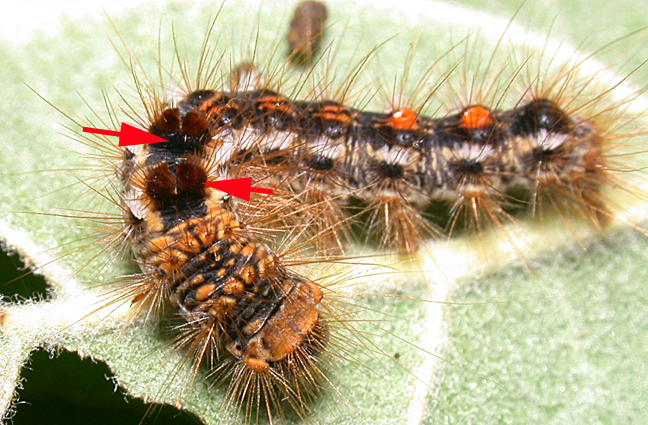Many species of social caterpillars are urticating, and the caterpillar of the brown-tail moth is no exception. The aggregated caterpillars, constituting a large mass of potential food, would be particularly attractive to bird predators were it not for the fact that they are rendered unpalatable not only by the long copious hairs that invest their bodies but by short poisonous setae as well. When the caterpillar first invaded New England, residents of infested areas experienced mild to severe rashes. Initially, the cause of the problem was not recognized and there was concern among affected individuals that a new contagious disease had arrived. The cause of the trouble was soon traced to the shed and wind-disseminated hairs of the caterpillars. To quote a resident of Somerville:
“While cutting the limbs from the infested trees my husband was badly poisoned, his eyes in particular being affected. In cleaning the window screens in the house I was also badly poisoned; the skin of my body was as much inflamed as if a mustard paste had been applied. The poisoning did not seem to come entirely from contact, but the air seemed to be filled with something which caused the itching and burning sensation. We were affected during the whole two months that the insect was in the larval stage. In 1897, while the house was being painted, the painters all suffered more or less. Their distress was so great that they were obliged to stop their work and bathe the face, hands and aims with soda water to get relief. We could not hang out the clothes, as the hairs would cling to them, especially to the flannels, and when worn they would badly irritate the skin.”
The setae that cause the most severe irritation appear in the third and subsequent instars. These hairs are very small, approximately 0.1 mm in length, sharp pointed and barbed. They occur on the upper surface of first and second abdominal segments. They are easily detached and the loose hairs can become airborne. They lodge in the silk of the cocoon as it is spun by the caterpillar and can adhere to the emerging adult which then disseminates them.
It was originally thought that the irritation caused by the hair was purely mechanical but it is now known to be due to chemical toxins as well. The offending setae are hollow and when attached to the caterpillar have at their base canals that lead to poison glands in epidermis of the caterpillar, the liquid of which floods the interior of the seta. When they dislodge and penetrate the skin of the victim, the setae spill their contents, causing the rash. Analysis has shown that the irritants produced by the caterpillar include histamine and a number of enzymes. While in most people the combined effect of the mechanical and chemical assault causes only a mild rash, some individuals experience a much more severe reaction Both immediate and delayed-type hypersensitivity reactions have been reported and at least one individual has died from an immune system reaction to the insect.
Dermatitis from expoure to the urticating setae of the brown-tail moth caterpillars. (Photo: Wikimedia commons)
Setal types found on the caterpillars of the brown-tail moth caterpillar. The short setae in illustration 3 are urticating, causing a rash on contact. Plate from Fernald and Kirkland (1903)
The setae causing the most severe irritation are found on the four pads that occur on the dorsal surface of the first and second abdominal segements (arrows)
.jpg)
.jpg)
